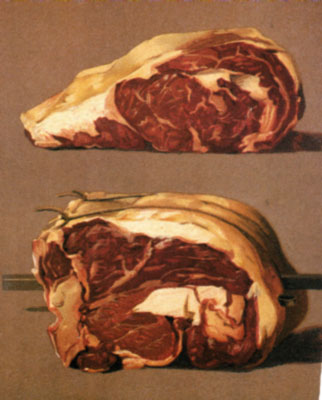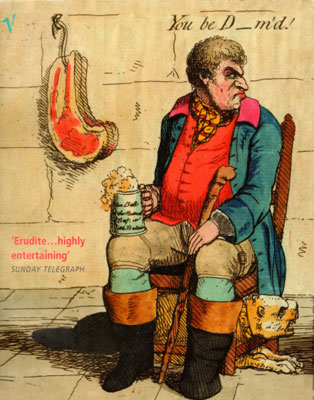Potted beef.
The English traditionally potted all kinds of meat and seafood under a layer of clarified butter. The original purpose of potting was preservation: The butter cap blocked bacteria and other nasties from the food beneath. Like other preservative methods that survive the age of pasteurization, refrigeration, shrink wrapping and more, potting has a side-effect. It tastes good.
Potted shrimp still appears on British restaurant menus, and although the preparation is virtually unknown in the United States, James Beard included his own variation in Delights and Prejudices, if back in 1964.
Many variations on potted beef appear in old English cookbooks. Our first recipe is based on Elizabeth Ayrton and is easier than Beard’s version, which follows it.
This recipe fills two four-inch ramekins.

- 1 ½ lb good hamburger
- ¼ lb lean bacon, minced in a food processor or chopped fine
- black pepper to taste
- 1 teaspoon salt
- ¼ teaspoon ground cloves
- ½ teaspoon mace
- ¼ teaspoon ground nutmeg
- about 6 oz good red wine
- 4-6 Tablespoons unsalted butter
Preheat the oven to 300°.
- Combine everything but the wine and butter in a food processor until you have a smooth, thick paste, a little denser than peanut butter. The texture should be uniform.
- Stir in the wine along with a very little water and spoon the mixture into a buttered casserole or bread pan.
- Dot the paste with the butter, cover the container tightly and place it in a bain marie (or pan of water that reaches halfway up the container of the paste) and bake for about 2 ½ hours.
- Drain away the liquid and fatty scum that has collected in the pan, press the paste gently to remove more excess moisture, and pack the paste tightly into the ramekins.
- Cover each ramekin with plastic wrap, place a heavy jar or can on top and refrigerate overnight.
- Pour melted clarified butter or ghee over each ramekin and rechill until the butter hardens.
Potted beef another way: James Beard’s Strathborough Paste.
- 2 lb stewing beef of any kind and some bones if you have them
- 2-3 leeks, cleaned and split - 2 carrots, peeled and split
- 2 carrots, peeled and split
- 1 unpeeled onion stuck with 3 cloves
- 1 teaspoon dried thyme
- 2-3 sprigs parsley
- 1 teaspoon salt
- Worcestershire to taste
- 1 Tablespoon anchovy paste
- 1-2 Tablespoons brandy
- ¼ teaspoon white pepper
- ¼ teaspoon nutmeg
- ¼ teaspoon ground ginger (or substitute the more traditional mace)
- ¼ teaspoon ground cloves
- 4-6 oz unsalted butter at room temperature
- melted clarified butter or ghee
- Simmer the beef, vegetables, thyme, parsley, salt and Worcestershire in water just to cover for 3-4 hours, or until tender but not stringy.
- Let the meat cool, separate it from everything else, then combine it with the anchovy, brandy, white pepper and spices.
- Strain and keep the stock; you may need a drip or two for the paste and it will make a good soup.
- Zap the mixture in a food processer to break it up, then add the butter and process again until you have a thickish paste.
- If the mixture does not cohere, add a little of the cooking stock.
- Spoon the mixture into ramekins and top each one with a thin layer of the melted butter.
Notes:
- If you have leftover beef that is not too dire, skip Step 1 and use it.
- The proportions in this recipe make a very thick paste, so thick that the Editor has burnt out the motor of a blender in attempting to make the dish. You really need a food processer for this recipe.
- Serve potted beef with toast or cream crackers, mustard and cornichon or pickled onions or both. If you are feeling flush and can find them, pickled walnuts are even better.

